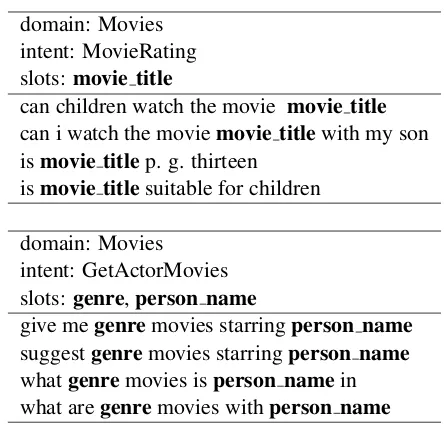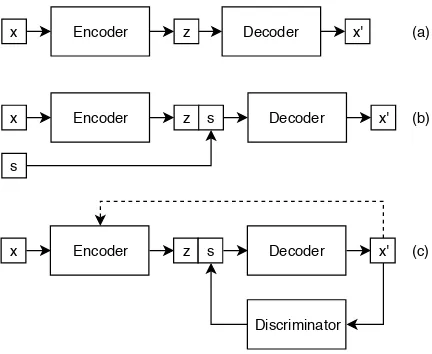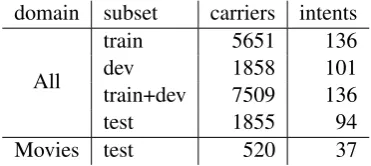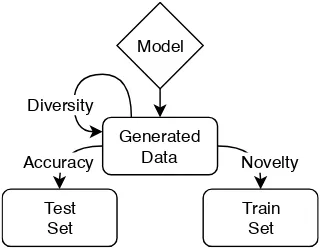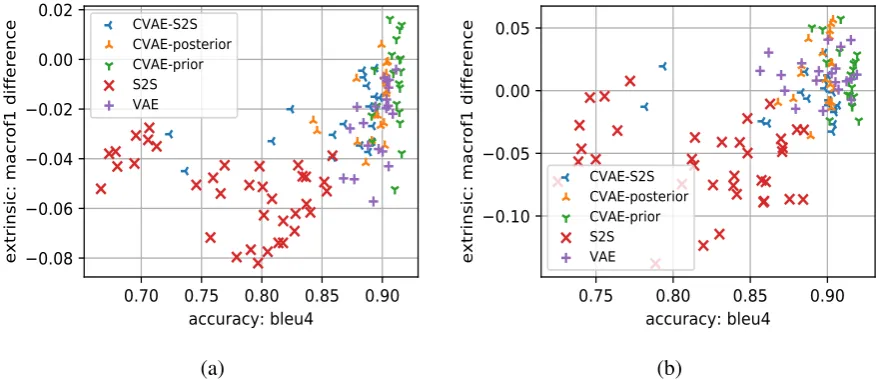Proceedings of the 3rd Workshop on Neural Generation and Translation (WNGT 2019), pages 90–98 90
Controlled Text Generation for Data Augmentation in Intelligent
Artificial Agents
Nikolaos Malandrakis1, Minmin Shen2, Anuj Goyal2, Shuyang Gao2, Abhishek Sethi2, Angeliki Metallinou2
1Signal Analysis and Interpretation Laboratory (SAIL), USC, Los Angeles, CA 90089 2 Amazon Alexa AI
malandra@usc.edu,
{shenm,anujgoya,shuyag,abhsethi,ametalli}@amazon.com
Abstract
Data availability is a bottleneck during early stages of development of new capabilities for intelligent artificial agents. We investigate the use of text generation techniques to augment the training data of a popular commercial ar-tificial agent across categories of functional-ity, with the goal of faster development of new functionality. We explore a variety of encoder-decoder generative models for synthetic train-ing data generation and propose ustrain-ing condi-tional variacondi-tional auto-encoders. Our approach requires only direct optimization, works well with limited data and significantly outperforms the previous controlled text generation tech-niques. Further, the generated data are used as additional training samples in an extrinsic intent classification task, leading to improved performance by up to 5% absolute f-score in low-resource cases, validating the usefulness of our approach.
1 Introduction
Voice-powered artificial agents have seen widespread commercial use in recent years, with agents like Google’s Assistant, Apple’s Siri and Amazon’s Alexa rising in popularity. These agents are expected to be highly accurate in understanding the users’ requests and to be capable of handling a variety of continuously expanding functionality. New capabilities are initially defined via a few phrase templates. Those are expanded, typically through larger scale data collection, to create datasets for building the machine learning algorithms required to create a serviceable Natural Language Understanding (NLU) system. This is a lengthy and expensive process that is repeated for new functionality expansion and can significantly slow down development time.
We investigate the use of neural generative encoder-decoder models for text data generation.
Given a small set of phrase templates for some new functionality, our goal is to generate new semanti-cally similarphrases and augment our training data. This data augmentation is not necessarily meant as a replacement for large-scale data collection, but rather as a way to accelerate the early stages of new functionality development. This task shares similarities with paraphrasing. Therefore, inspired by work in paraphrasing (Prakash et al.,2016) and controlled text generation (Hu et al.,2018), we in-vestigate the use of variational autoencoder models and methods to condition neural generators.
For controlled text generation, (Hu et al.,2018) used a variational autoencoder with an additional discriminator and trained the model in a wake-sleep way. (Zhou and Wang,2018) used reinforcement via an emoji classifier to generate emotional re-sponses. However, we found that when the num-ber of samples is relatively small compared to the number of categories, such an approach might be counter-productive, because the required classifier components can not perform well. Inspired by re-cent advantages of connecting information theory with variational auto-encoders and invariant fea-ture learning (Moyer et al.,2018), we instead use this approach to our controlled text generation task, without a discriminator.
Furthermore, our task differs from typical para-phrasing in that semantic similarity between the output text and the NLU functionality is not the only objective. The synthetic data should be eval-uated in terms of its lexical diversity and novelty, which are important properties of a high quality training set.
Our key contributions are as follows:
setting.
• We validate our method in an extrinsic intent classification task, showing that the generated data brings considerable accuracy gains in low resource settings.
2 Related Work
Neural networks have revolutionized the field of text generation, in machine translation (Sutskever et al.,2014), summarization (See et al.,2017) and image captioning (You et al.,2016). However, con-ditional text generation has been relatively less stud-ied as compared to conditional image generation and poses some unique problems. One of the issues is the non-differentiability of the sampled text that limits the applicability of a global discriminator in end-to-end training. The problem has been rela-tively addressed by using CNNs for generation ( Ra-jeswar et al.,2017), policy gradient reinforcement learning methods including SeqGAN (Yu et al.,
2017), LeakGAN (Guo et al.,2018), or using latent representation like Gumbel softmax ((Jang et al.,
2016)). Many of these approaches suffer from high training variance, mode collapse or cannot be eval-uated beyond a qualitative analysis.
Many models have been proposed for text gen-eration. Seq2seq models are standard encoder-decoder models widely used in text applications like machine translation (Luong et al.,2015) and paraphrasing (Prakash et al., 2016). Variational Auto-Encoder (VAE) models are another important family (Kingma and Welling,2013) and they con-sist of an encoder that maps each sample to a latent representation and a decoder that generates sam-ples from the latent space. The advantage of these models is the variational component and its poten-tial to add diversity to the generated data. They have been shown to work well for text generation (Bowman et al.,2016). Conditional VAE (CVAE) (Kingma et al.,2014) was proposed to improve over seq2seq models for generating more diverse and relevant text. CVAE based models (Serban et al.,
2017;Zhao et al.,2017;Shen et al.,2017;Zhou and Wang,2018) incorporate stochastic latent variables that represents the generated text, and append the output of VAE as an additional input to decoder.
Paraphrasing can be performed using neural net-works with an encoder-decoder configuration, in-cluding sequence to sequence (S2S) (Luong et al.,
2015) and generative models (Bowman et al.,2016) and various modifications have been proposed to
domain: Movies intent: MovieRating slots:movie title
can children watch the movie movie title
can i watch the moviemovie titlewith my son ismovie titlep. g. thirteen
ismovie titlesuitable for children
domain: Movies intent: GetActorMovies slots:genre,person name
give megenremovies starringperson name
suggestgenremovies starringperson name
[image:2.595.304.526.57.269.2]whatgenremovies isperson namein what aregenremovies withperson name
Figure 1: Example of template carrier phrases for two signaturess.
allow for control of the output distribution of the data generation (Yan et al.,2015;Hu et al.,2018). Unlike the typical paraphrasing task we care about the lexical diversity and novelty of the gener-ated output. This has been a concern in paraphrase generation: a generator that only produces trivial outputs can still perform fairly well in terms of typical paraphrasing evaluation metrics, despite the output being of little use. Alternative metrics have been proposed to encourage more diverse outputs (Shima and Mitamura, 2011). Typically evalua-tion of paraphrasing or text generaevalua-tion tasks is per-formed by using a similarity metric (usually some variant of BLEU (Papineni et al.,2002)) calculated against a held-out set (Prakash et al., 2016; Ra-jeswar et al.,2017;Yu et al.,2017).
3 Methodology
3.1 Problem Definition
phrase. Given a small amount of example carrier phrases for a given signature of a new capability (typically under 5 phrases), our goal is to generate additional semantically similar carrier phrases for the target signature.
The core challenge lies in the very limited data we can work with. The low number of phrases per category is, as we will show, highly problematic when training some adversarial or reinforcement structures. Additionally the high number of cate-gories makes getting an output of the desired signa-ture harder, because many similar signasigna-tures will be very close in latent space.
Encoder z s Decoder
Discriminator
x x'
Encoder z Decoder
x x'
Encoder z s Decoder
x x'
s
(a)
(b)
[image:3.595.72.288.248.425.2](c)
Figure 2: The variants of VAE we used: (a) VAE, (b) Conditional VAE (CVAE) and (c) VAE with discrimi-nator
3.2 Generation models
Following is a short description of the models we evaluated for data generation. For all models we assume we have training carrier phrasesci ∈Dstr
across signaturess, and we pool together the data from all the signatures for training. The variational auto-encoders we used can be seen in Fig2.
Sequence to Sequence with Attention Here, we use the seq2seq with global attention proposed in (Luong et al.,2015) as our baseline generation model. The model is trained on all input-output pairs of carrier phrases belonging to the same sig-natures, e.g.,c1, c2 ∈Dstr. At generation, we aim to control the output by using an input carrier of the target signatures.
Variational Auto-Encoders (VAEs) The VAE model can be trained with a paraphrasing objec-tive, e.g., on pairs of carrier phrasesc1, c2 ∈Dstr, similarly to the seq2seq model. Alternatively, the
VAE model can be trained with a reconstruction ob-jective e.g.,c1∈Dtr can be both the input and the
output. However, if we train with a reconstruction objective, during generation, we ignore the encoder and randomly sample the VAE priorz(typically from a normal distribution). As a result, we have no control over the output signature distribution, and we may generate any of the signatures sin our training data. This disadvantage motivates the investigation of two controlled VAE models.
VAE with discriminator is a modification of a VAE proposed by (Hu et al.,2018) for a similar task of controlled text generation. In this case, adversar-ial type of training is used by training a discrimina-tor, i.e., a classifier for the category (signatures), to explicitly enforce control over the generated out-put. The network is trained in steps, with the VAE trained first, then the discriminator is attached and the entire network re-trained using a sleep-wake process. We tried two variations of this, one train-ing a VAE, another traintrain-ing a CVAE, before addtrain-ing the discriminator. Note that control over the output depends on the discriminator performance. While this model worked well for controlling between a small number of output categories as in (Hu et al.,
2018), our setup includes hundreds of signatures
s, which posed challenges in achieving accurate control over the output phrases (Sec.5.2).
Conditional VAE (CVAE) Inspired by (Moyer et al.,2018) for invariant feature learning, we pro-pose to use a CVAE based controlled model struc-ture. Such structure is a modification on the VAE, where we append the desired category label, here signature s, in 1-hot encoding, to each step of the decoder without an additional discriminator as shown in (Hu et al.,2018). Note that the orig-inal conditional VAE has already been applied to controlled visual settings (Yan et al.,2015). It has been shown that by direct optimizing the loss, this model automatically learns a invariant representa-tionzthat is independent of the category (signature
during generation we randomly sample fromzbut can control the output signature by settings.
All model encoders and decoders are GRUs. For the discriminator we tried CNN and LSTM with no significant performance differences.
4 Datasets
We experiment on two datasets collected for Alexa, a commercial artificial agent.
Movie dataset It contains carrier phrases that are created as part of developing new movie-related functionality. It is composed of 179 signatures defined with an average of eight carrier phrases each. This data represents a typical new capability that starts out with few template carriers phrases, and we use it to examine if this low resource dataset can benefit from synthetic data generation.
Live entertainment dataset It contains live cus-tomer data from deployed entertainment related capabilities (music, books, etc), selected for their semantic relevance to movies. These utterances were de-lexicalized by replacing slot values with their respective slot types. We used a frequency threshold to filter out rare carrier phrases, and en-sure a minimum number of three carrier phrases per signature.
Table1shows the data splits for the movie, live entertainment and ‘all’ datasets, the latter containg both movies and live entertainment data, in-cluding the number of signatures, slot types and unique non-slot words in each set. While the data splits were stratified, signatures with fewer than four carriers were placed only in the train set, lead-ing to the discrepancy in signature numbers across partitions.
5 Experiments
5.1 Experimental setup
At the core of our data augmentation task lies the question “what defines a good training data set?”. We can evaluate aspects of the generated data via synthetic metrics, but the most reliable method is to generate data for an extrinsic task and evaluate any improvements in performance. In this paper we employ both methods are reporting results for intrinsic and extrinsic evaluation metrics.
For the intrinsic evaluation, we train the data generator either only on movie data or on ‘all’ data (movies and entertainment combined), using the re-spective dev sets for hyper-parameter tuning.
Dur-ing generation, we similarly consider either the movies test set, or the ‘all’ test set, and aim to generateten synthetic phrasesper test set phrase. VAE type generators can be trained for paraphras-ing (c1→c2) or reconstruction (c1→c1). During generation, sampling can be performed either from the prior, e.g., by ignoring the encoder and sam-plingz∼ N(0, I)to generate an output, or from the posterior e.g., usingc1as input to the encoder and producing the output c2. Note that not all combinations are applicable to all models. Those applicable are shown in Table3, where ‘para’, ‘re-con’, ‘prior’ and ‘post’ denote paraphrasing, recon-struction, prior and posterior respectively. Special handling was required for a VAE with reconstruc-tion training and prior sampling, where we have no control over the output signature. To solve this, we compared each output phrase to every signature in the train set (via BLEU4 (Papineni et al.,2002)) and assigned it to the highest scoring signature. Some sample output phrases can be seen in Fig.3. To examine the usefulness of the generated data for an extrinsic ask, we perform intent classifica-tion, a standard task in NLU. Our classifier is a BiL-STM model. We use the same data as for the data generation experiments (see Table1), and group our class labels into intents (as opposed to signa-tures), which leads to classifying 136 intents in the combined movies and entertainment data (‘all’). Our setup follows two steps: First, the data gen-erators are trained on ‘all’ train sets, and used to generate phrases for the dev sets (‘all’ and movies). Second, the intent classifier is trained on the ‘all’ train and dev sets (baseline), vs the combination of ‘all’ train, dev and generated synthetic data, which is our proposed approach. We evaluate on the ‘all’ and movies test sets, and use macro-averaged F-score across all intents as our metric.
5.2 Intrinsic evaluation
domain subset carriers signatures slots words
Movies
train 1,382 179 21 353
dev 622 109 15 292
test 520 69 10 254
Live Entertainment
train 4269 588 120 332
dev 1236 244 77 194
test 1335 271 74 217
All
[image:5.595.152.449.61.199.2]train 5,651 767 141 685 dev 1,858 353 92 486 test 1,855 340 84 471
Table 1: Data distribution and splits. ‘All’ contains the combined Movie and Entertainment live datasets
domain subset carriers intents
All
train 5651 136
dev 1858 101
train+dev 7509 136
test 1855 94
[image:5.595.88.274.241.324.2]Movies test 520 37
Table 2: Data distribution and splits for the extrinsic task.
evaluate accuracy we compare the generated data to a held outtest setusing BLEU4 (Papineni et al.,
2002) and the slot carry-over rate, the probability that a generated phrase contains the exact same slot types as the target signatures. To evaluate novelty we compare the generated data to the train set of the generator, using 1-BLEU4 (where higher is bet-ter) and 1-Match rate, where the match rate is the chance that a perfect match to a generated phrase exists in the train set. These scores tell us how different, at the lexical level, the generated phrases are to the phrases that already exist in the train set. Finally, to evaluate diversity we compare the phrases in the generated data to each other, using again 1-BLEU4 and the unique rate, the number of unique phrase produced over the total number of phrases produced. These scores indicate how lexically different the generated phrases are to each other. Figure4shows the set comparisons made to generate the intrinsic evaluation metrics. Note that these metrics mostly evaluate surface forms; we expect phrases generated for the same signature to besemanticallysimilar to phrases with the same signature in the train set and to each other, how-ever we would like them to belexicallynovel and diverse.
Table3presents the intrinsic evaluation results, where generators are trained and tested on ‘all’ data,
for the best performing model per case, tuned on the dev set. First, note the slot carry over (slot c.o.), which can be used as a sanity check measuring the chance of getting a phrase with the desired slot types. Most models reach 0.8 or higher slot c.o. as expected, but some fall short, indicating failure to produce the desired signature. The failure for VAE and CVAE models with discriminators is most notable, and can be explained by the fact that we have a large number of train signatures (∼800) and too few samples per signature (mean 8, median 4), to accurately train the discriminator. We ver-ified that the discriminator overall accuracy does not exceed 0.35. The poor discriminator perfor-mance leads to the decoder not learning how to use signatures. The failure of VAE with posterior sam-pling is similarly explained by the large number of signatures: the signatures are so tightly packed in the latent space, that the variance of samplingzis likely to result in phrases from similar but different signatures.
Model: S2S
Input: i negation feel like watching a movie withperson name
outputs
inegationlike movies byperson name
inegationfeel like watching movies byperson name
inegationfeel like watching a movie byperson name
inegationlikeperson name
inegationfeel like watching a movie inegationwant to talk aboutperson name
no inegationlikeperson namemovies
Model: VAE, sampling from prior distribution
Input: GetMovieAwards (intent) -award title,movie title(slots)
outputs
didmovie titlewin anaward title
anyaward titlewon bymovie title
tell me anyaward titlewhichmovie titlewon
wasmovie titlenominated for anaward titlethe moviemovie title
anyaward titleformovie title
what are theaward titlewhichmovie titlewon give me anyaward titlethe movie was nominated for
Model: CVAE, sampling from prior distribution
Input: GetActorMovies (intent) -genre,person name(slots)
outputs
give megenremovies starringperson name
show me othergenremovies withperson namein it what are thegenremovies thatperson namestarred in tell megenremovies starringperson name
what aregenremovies withperson name genremovies starringperson name
[image:6.595.127.473.57.452.2]suggestgenremovies starringperson name
Figure 3: Sample output phrases. The S2S model and all posterior sampling models use a phrase as an input. For prior sampling the desired signature is the model input.
Novelty Generated
Data
Train Set Test
Set Diversity
Accuracy
Model
Figure 4: Intrinsic evaluation overview
to accuracy within the hyper-parameter constraints of each model. However the trade-off is not equally steep for all models. Across our experiments the VAE and CVAE models with reconstruction train-ing and prior sampltrain-ing provided the most favorable trade-offs with CVAE being the best option for very
high accuracy, as seen in Fig.5.
[image:6.595.101.261.512.637.2]S2S VAE VAE+DISC CVAE CVAE+DISC training para recon para recon recon recon para recon sampling post prior post prior prior post post prior
accuracy BLEU4 0.86 0.91 0.24 0.42 0.91 0.88 0.90 0.11 slot c.o. 0.84 0.95 0.02 0.12 0.98 0.93 0.95 0.01
diversity 1-BLEU4 0.06 0.19 0.83 0.84 0.14 0.23 0.33 0.19 uniq. rate 0.58 0.68 0.98 0.76 0.44 0.56 0.68 0.97
[image:7.595.82.518.61.189.2]novelty 1-BLEU4 0.25 0.07 0.75 0.98 0.04 0.12 0.21 0.99 1-match rate 0.89 0.76 0.99 1.00 0.32 0.50 0.59 1.00
Table 3: Best performance per metric for each model when applied to ‘all’ domains.
metric % change
CVAE CVAE CVAE VAE prior posterior s2s prior
accuracy
BLEU4 -0.7% -0.7% -4.3% -2.0% slot c.o. -2.7% -3.1% -9.5% -5.9%
diversity
1-BLEU4 112.1% 103.6% 133.7% 134.6% uniq. rate 19.6% 19.7% 32.7% 37.1%
novelty
[image:7.595.175.423.219.387.2]1-BLEU4 147.1% 40.7% 222.1% 201.2% 1-match rate 113.5% 36.7% 145.4% 90.1%
Table 4: Relative change when adding more training data for generator training (movies only vs ‘all’) across evaluation metrics on the movies test set
0.3 0.4 0.5 0.6 0.7
diversity: uniq. rate 0.65
0.70 0.75 0.80 0.85 0.90
accuracy: bleu4
S2S VAE CVAE-prior CVAE-posterior CVAE-S2S
Figure 5: Intrinsic accuracy BLEU4 as a function of in-trinsic diversity for the ‘all’ test set for multiple hyper-parameter combinations of each model.
5.3 Extrinsic Evaluation
In Figure6we present the change in the F1 score for intent classification when adding the gener-ated data into the classifier training (compared to the baseline classifier with no generated data) as
[image:7.595.77.289.446.612.2]0.70 0.75 0.80 0.85 0.90
accuracy: bleu4
0.08
0.06
0.04
0.02
0.00
0.02
extrinsic: macrof1 difference
CVAE-S2S CVAE-posterior CVAE-prior S2S VAE
0.75
0.80
0.85
0.90
accuracy: bleu4
0.10
0.05
0.00
0.05
extrinsic: macrof1 difference
CVAE-S2S CVAE-posterior CVAE-prior S2S VAE
[image:8.595.80.527.71.261.2](a) (b)
Figure 6: Extrinsic task performance change as a function of intrinsic accuracy BLEU4 for (a) all domains and (b) the movies domain. Theyaxis represents how much performance improved or deteriorated after adding synthetic data to the train set.
intent on average, 41.55 instead of 24.25), there-fore harder to improve using synthetic data. Note that the baseline F1 scores (no synthetic data) are 0.58 for movies and 0.60 for the ‘all’ test set.
We investigate the correlation between the intrin-sic metrics and the extrinintrin-sic F score by performing Ordinary Least Squares (OLS) regression between the two types of metrics, computed on the ‘all’ test set. We find that intrinsic accuracy metrics like BLEU4 and slot c.o. have significant positive correlation with macro F (R2of 0.31 and 0.40 re-spectively,p≈0) across all experiments/models, though perhaps not as high as one might expect. We also computed via OLS the combined predic-tive power of all intrinsic metrics for predicting extrinsic F, and estimated anR2 coefficient of 0.53 (p ≈ 0). The diversity and novelty metrics add a lot of predictive power to the OLS model when combined with accuracy metrics, raising R2from 0.40 to 0.53, validating the need to take these as-pects of NLG performance into account. However, intrinsic diversity and novelty are only good predic-tors of extrinsic performance when combined with accuracy, so they only become significant when comparing models of similar intrinsic accuracy.
6 Conclusions
We described a framework for controlled text gener-ation for enriching training data for new NLU func-tionality. Our challenging text generation setup required control of the output phrases over a large number of low resource signatures of NLU
func-tionality. We used intrinsic metrics to evaluate the quality of the generated synthetic data in terms of accuracy, diversity and novelty. We empiri-cally investigated variational encoder-decoder type models and proposed to use a CVAE based model, which yielded the best results, being able to gener-ate phrases with favorable accuracy, diversity and novelty trade-offs. We also demonstrated the use-fulness of our proposed methods by showing that the synthetic data can improve the accuracy of an extrinsic low resource classification task.
7 Acknowledgments
This work was performed while Nikolaos Malan-drakis was at Amazon Alexa AI, Sunnyvale.
References
Samuel R. Bowman, Luke Vilnis, Oriol Vinyals, An-drew M. Dai, Rafal Jozefowicz, and Samy Ben-gio. 2016. Generating sentences from a continu-ous space. InProceedings of the SIGNLL Confer-ence on Computational Natural Language Learning (CONLL), pages 10–21.
Jiaxian Guo, Weinan Zhang Yong Yu Sidi Lu, Han Cai, and Jun Wang. 2018. Long text generation via ad-versarial training with leaked information. In Pro-ceedings of AAAI, pages 5141–5148.
Eric Jang, Shixiang Gu, and Ben Poole. 2016. Cat-egorical reparameterization with gumbel-softmax. arXiv:1611.01144.
Diederik P Kingma, Shakir Mohamed, Danilo Jimenez Rezende, and Max Welling. 2014. Semi-supervised learning with deep generative models. InAdvances in Neural Information Processing Systems, pages 3581–3589.
Diederik P Kingma and Max Welling. 2013. Auto-encoding variational bayes. arXiv:1312.6114.
Minh-Thang Luong, Hieu Pham, and Christo-pher D. Manning. 2015. Effective approaches to attention-based neural machine translation. arXiv:1508.04025.
Daniel Moyer, Shuyang Gao, Rob Brekelmans, Aram Galstyan, and Greg Ver Steeg. 2018. Invariant repre-sentations without adversarial training. InAdvances in Neural Information Processing Systems 31, pages 9101–9110.
Kishore Papineni, Salim Roukos, Todd Ward, and Wei-Jing Zhu. 2002. Bleu: A method for automatic eval-uation of machine translation. InProceedings of the 40th Annual Meeting on Association for Computa-tional Linguistics, pages 311–318.
Aaditya Prakash, Sadid A. Hasan, Kathy Lee, Vivek Datla, Ashequl Qadir, Joey Liu, and Oladimeji Farri. 2016. Neural paraphrase generation with stacked residual lstm networks. arXiv:1610.03098.
Rajeswar, Subramanian S., Dutil F., Pal C., and A. Courville. 2017. Adversarial generation of nat-ural language. arXiv:1705.10929.
Abigail See, Peter J. Liu, and Christopher D. Manning. 2017. Get to the point: Summarization with pointer generator networks. InProceedings of ACL, pages 1073–1083.
Iulian Vlad Serban, Alessandro Sordoni, Ryan Lowe, Laurent Charlin, Joelle Pineau, Aaron C Courville, and Yoshua Bengio. 2017. A hierarchical latent variable encoder-decoder model for generating dia-logues.InAAAI, pages 3295–3301.
Xiaoyu Shen, Hui Su, Yanran Li, Wenjie Li, Shuzi Niu, Yang Zhao, Akiko Aizawa, and Guoping Long. 2017. A conditional variational framework for dia-log generation. arXiv:1705.00316.
Hideki Shima and Teruko Mitamura. 2011. Diversity-aware evaluation for paraphrase patterns. In Pro-ceedings of the TextInfer 2011 Workshop on Textual Entailment, pages 35–39.
Ilya Sutskever, Oriol Vinyals, and Quoc V Le. 2014.
Sequence to sequence learning with neural networks. Advances in neural information processing systems, pages 3104–3112.
Xinchen Yan, Jimei Yang, Kihyuk Sohn, and Honglak Lee. 2015.Attribute2image: Conditional image gen-eration from visual attributes. arXiv:1512.00570.
Quanzeng You, Chen Fang Hailin Jin, Zhaowen Wang, and Jiebo Luo. 2016. Image captioning with seman-tic attention. InProceedings of the IEEE conference on computer vision and pattern recognition, pages 4651–4659.
Lantao Yu, Jun Wang Weinan Zhang, and Yong Yu. 2017.Seqgan: Sequence generative adversarial nets with policy gradient.InProceedings of AAAI, pages 2852–2858.
Tiancheng Zhao, Ran Zhao, and Maxine Eskenazi. 2017. Learning discourse-level diversity for neural dialog models using conditional variational autoen-coders. arXiv:1703.10960.
